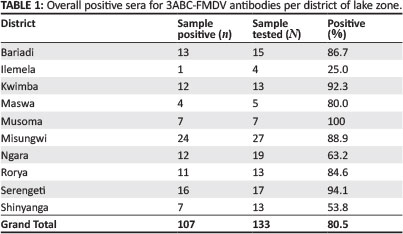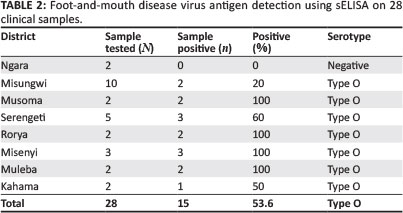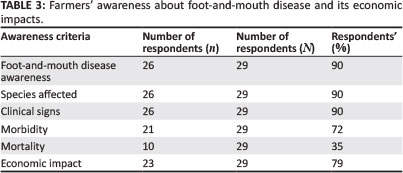Services on Demand
Article
Indicators
Related links
-
 Cited by Google
Cited by Google -
 Similars in Google
Similars in Google
Share
Onderstepoort Journal of Veterinary Research
On-line version ISSN 2219-0635
Print version ISSN 0030-2465
Onderstepoort j. vet. res. vol.81 n.2 Pretoria Feb. 2014
PROCEEDINGS
Spatial and temporal distribution of foot-and-mouth disease virus in the lake zone of Tanzania
Joseph M. GenchwereI; Christopher J. KasangaII
ITanzania Veterinary Laboratory Agency, Mwanza, Tanzania
IISokoine University of Agriculture, Chuo Kikuu, Tanzania
ABSTRACT
This study was conducted to determine the spatiotemporal distribution of foot-and-mouth disease (FMD) virus (FMDV) serotypes and evaluate the awareness of livestock keepers about FMD in Tanzania. An observational prospective study involving serological analysis, FMDV antigen detection and questionnaire survey was carried out in the lake zone of Tanzania.
Seroprevalence of antibodies to the nonstructural protein 3ABC of FMDV and serotype- specific antigen detection were investigated by using SVANOVIR® FMDV 3ABC-Ab ELISA and indirect-sandwich ELISA (sELISA), respectively, whilst a structured questionnaire was used to evaluate the awareness of livestock keepers about FMD. During the period of 2010-2011, both serum and tissue (foot-and-mouth epithelia) samples were collected from cattle suspected of FMD in 13 districts of the four regions of the lake zone. A total of 107 (80.5%) out of 133 tested serum samples were seropositive to nonstructural protein 3ABC, with at least one sample being positive from all 10 districts screened. Fifteen (53.6%) out of 28 tissue epithelial samples collected from FMD cases in eight districts during the course of this study were positive to serotype O FMDV antigen. Of these eight districts, serotype O FMDV antigens were detected from seven districts and no other serotypes were recovered from animal samples screened.
Questionnaire surveys in six districts indicated that livestock keepers in the lake zone were aware of the clinical manifestations (26/29 = 90.0%) and economic impact (23/29 = 79.0%) of FMD in the region. The questionnaire data showed that FMD outbreaks often occurred after rainy seasons (22/29 = 75.9%), with the highest peaks predominantly occurring just after the long rains in May and June, and at the end of the short rains in November and December of each year. The spatial distribution of the FMD cases suggested that serotype O virus exposure was the only widespread cause of the 2010-2011 outbreaks in the lake zone.
Introduction
Foot-and-mouth disease (FMD) is a highly contagious, vesicular disease of cloven-hoofed animal species (Habiela et al. 2010). It is caused by the foot-and-mouth disease virus (FMDV) of the genus Aphthovirus and the family Picornaviridae (Carrillo et al. 2005; OIE 2009). There are seven distinct serotypes, namely: O, A, C, South African Territories (SAT) 1, SAT 2, SAT 3, and Asia 1 (APHIS 2007; OIE 2009; Paton et al. 2009).
Since FMD was first reported in Tanzania in 1927 (Tanganyika Department of Veterinary Services 1927; Chibunda et al. 2006), efforts to eradicate this economically important disease have not been fruitful, as there are still several FMD outbreaks (long-standing endemic or periodic epidemics) being encountered. The occurrence and geographical distribution of FMDV serotypes is not clearly known and this remains to be fully explored.
This study was conducted in order to determine the current spatial and temporal distribution of the FMDV serotypes, to evaluate the awareness of livestock keepers about FMD and its socioeconomic impact in the lake zone of Tanzania.
Materials and methods
Sample collection and methodology
An observational, prospective study involving serological analysis, FMDV antigen detection and questionnaire survey was carried out. Serum and epithelial tissue samples were collected from cattle suspected of FMD in 13 districts during the period of 2010-2011.
Seroprevalence of antibodies to the nonstructural protein 3ABC of FMDV were investigated by using SVANOVIR® FMDV 3ABC-Ab ELISA (Svanova Biotech AB, Sweden) and developed in collaboration with CEVAN (Centro Virologia Animal), (COREPRO Buenos Aires, Argentina). Serotype-specific antigen detection was investigated by indirect-sandwich ELISA (sELISA) supplied by the Institute for Animal Health (Pirbright Laboratory, UK); the procedure was as described by Roeder and Le Blanc Smith (1987) and Ferris and Dawson (1988).
Structured questionnaires were used to evaluate the awareness of livestock keepers about FMD and its socioeconomic impact.
Data analysis
Descriptive statistics for laboratory data of both sELISA and non-structural protein 3ABC ELISA were used and frequency distributions were calculated (Thrusfield & Bertola 2005). Prevalence of positive animals was determined by dividing the number of positive serum samples by the total number of samples tested. For questionnaires, data were coded in such a way that variables (species affected, clinical signs, season and economic impacts) represented 1 and 0 for positive and negative awareness, respectively. All data were analysed with the Microsoft Excel® software (Microsoft, USA).
Results
A total of 107 (80.5%) out of 133 tested serum samples from cattle were seropositive to nonstructural protein 3ABC, with at least one sample being positive from all 10 districts screened (Table 1).

Fifteen (53.6%) out of 28 tissue epithelial samples collected from FMD cases in eight districts during the course of this study were positive to serotype O FMDV antigen. Of these eight districts, serotype O FMDV antigens were detected in seven districts and no other serotypes were recovered from animal samples screened (Table 2).

The questionnaire surveys in six districts indicated that livestock keepers in the lake zone were aware of the clinical manifestations 26/29 (90%) and economic impact 23/29 (79%) of FMD (Table 3).

The questionnaire data showed that FMD outbreaks often occurred after rainy seasons 22/29 (75.9%), with the highest peaks predominantly occurring just after the long rains (masika) in May and June, and at the end of the short rains (vuli) in November and December (Figure 1).

Discussion
The study shows that FMD is endemic and widely spread throughout all four regions of the lake zone of Tanzania (Table 1 and Figure 2). The disease is of high economic importance, especially to countries that have an intensive animal industry (Mwiine et al. 2010).

The questionnaire survey indicates that the group of livestock keepers was aware of the disease. They also described most of the clinical presentations of the disease very well; most of the signs listed for FMD 26/29 (90%), such as mouth and foot lesions, hypersalivation, anorexia and lameness, were consistent with what has been described by other researchers (Radostits et al. 1994; Jullu 2004; Tesfaye 2006; CFSPH 2007; Swai et al. 2009).
The findings of this study indicate a high correlation between livestock keepers' awareness of FMD and the serological diagnosis of FMDV infection by NSP 3ABC-Ab ELISA. These results also conform to the positive results obtained by sELISA test, which indicates 53.6% to be positive for FMDV serotype O in seven districts (Table 2).
This observation indicates a correlation between the laboratory results and the findings of the questionnaire survey about the awareness of livestock keepers on the clinical manifestation of FMD under the field conditions.
Seasonal incidence of FMD was found to be high at the end of the long rainy season (May and June) and also at the end of short rainy season (vuli) (November and December), as shown in Figure 1. The lowest incidence of FMD outbreak was reported during the long rainy season (masika) (March and April) and during August and September (Figure 1). The reasons for this observation could be ascribed to movement of animals searching for pastures and water. Many herds of cattle meet at such places, thereby hastening the spread of infection from one herd to another.
The FMD study on NSP 3ABC antibody detection revealed evidence of infection, and that spatial distribution of the disease in the lake zone was 80.5% (Table 1).
The study using sELISA revealed that the spatial distributions of FMD outbreaks in the year 2010-2011 in the lake zone were caused mainly by serotype O virus (Figure 2). These findings are in agreement with Rweyemamu et al. (2008), who reported that serotype O was the most widely prevalent serotype in most parts of the world, including Tanzania.

In this study, the detection of serotype O virus antigens in all four regions of the lake zone, which was reported to be negative by Swai et al. (2009) and Jullu (2004) in this zone, depicts the possibility of re-introduction of serotype O. This may be the cause of the acute epidemic (sporadic) outbreaks of FMD in almost all the districts of the lake zone. The reintroduction of type O virus could be due to loose and free border movement of animals (livestock and wildlife) to and from neighbouring countries, such as Kenya and Uganda in Eastern Africa. Furthermore, the spread of serotype O virus within the districts of the lake zone could be associated with movement of animals from one district or region to another during trade and marketing. It could also be associated with the long-distance grazing movements practiced by agro-pastoralists with large herds of cattle searching of pastures and water.
This study provides evidence that the presence of FMD is an endemic situation in almost all the districts and regions of the lake zone. Serotype O has been detected as the most, and probably the only, prevailing serotype in the lake zone of Tanzania during the 2010-2011 outbreaks.
Serotype O virus has not been detected in the lake zone for years; the research conducted by Jullu (2004), by using both sELISA and real time polymerase chain reaction (RT-PCR), reported only serotype SAT 1 in Musoma urban and SAT2 in Musoma Urban and Tarime from samples collected in 1999. Samples collected in 2003 in Ukerewe and Mwanza city detected serotypes SAT 2. Jullu (2004) used the same protocol and kit for sELISA as was used in the current study. However, serotype O was detected in the Northern Zone (Arusha), Eastern zone (Dar es Salaam) and Southern Highland (Iringa and Mbeya) from samples collected for the period 1997-2003 (Jullu 2004).
Swai et al. (2009) detected only serotypes SAT 1 and SAT 2 in the lake zone from samples collected between 1997 and 2004. Recently, findings by Kasanga et al. (2011) could not detect the presence of serotype O in the lake zone from the samples collected from 1967-2009.
The detection of only serotype O virus in samples collected in the lake zone during 2010 and 2011, which was not detected by other researchers (Jullu 2004; Swai et al. 2009; Kasanga et al. 2011), provides a great challenge to the routine disease surveillance.
The recent occurrence of epidemic (sporadic) outbreaks with the classical clinical signs signifies the naive immunity status of the animals. This situation can be probably due to introduction of either the new strain of serotype O virus or reintroduction of serotype O virus with variant pathogenicity, which was not present some years back. With regard to the location of the lake zone and the widespread finding of the FMDV serotype O in all four regions, the probability of the infection is either from the vaccines or from the neighbouring countries. This is because some farmers, especially from the Kagera region, do vaccinate their animals by using FMD polyvalent vaccine from Kenya; the rest of the zone has no recent history of FMD vaccination.
The current study highlights the FMDV serotype (serotype O) prevalence in the lake zone and also the extent of spatial distribution of FMD in this zone. This is an important step, as the information detailed in this study is useful in vaccine matching and selection of vaccine candidate strains for the region. This will help in the recommendation for an appropriate approach and proper control programme of FMD in Tanzania.
Conclusion
The spatial distribution of the FMD cases suggests that serotype O virus exposure was the only widespread cause of the 2010-2011 outbreaks in the lake zone of Tanzania. The temporal occurrence of FMD has been noted after rainy seasons, with the highest peaks predominantly encountered just after long rains and at the end of the short rains.
The observed agreement between the livestock keepers in the current study and previous veterinary literature regarding most of the exhibited signs of important cattle diseases has proven that in the lake zone, livestock keepers have great knowledge about FMD. This is especially regarding disease outbreak, period of occurrence, diagnosis of the disease and its economic impacts.
The research indicates that the disease is endemic in the lake zone. It suggests that extensive and regular sero-surveillance, virus isolation and characterisations of the field FMDV isolates need to be conducted for the possible development of a relevant vaccine from the local circulating field serotype or strains.
Acknowledgement
The authors would like to express their thanks to the Ministry of Livestock and Fisheries Development for sponsoring this research. Special thanks go to Dr Win Mleche (Former Director of Veterinary Services, Ministry of Livestock and Fisheries Development, Tanzania) and Dr Ezekia Ranga (SADC-TADs Coordinator in Tanzania) for their encouragement and unreserved help to provide us with FMDV kits meant for laboratory analysis of samples. They are very grateful to all staff at VIC-Mwanza for their support during field sample collection and storage and are highly indebted to the livestock keepers: for their utmost patience in responding to our questions during the questionnaire survey and targeted discussions, and for allowing us to collect samples from their animals. This work was supported by the Wellcome Trust Grant WT087546MA to the Southern African Centre for Infectious Diseases & Surveillance (SACIDS).
Competing interests
The authors declare that they have no financial or personal relationship(s) that may have inappropriately influenced them in writing this article.
Authors' contributions
J.M.G. (Tanzania Veterinary Laboratory Agency -Mwanza) was the research project leader. C.J.K. (Sokoine University of Agriculture) was the research project supervisor.
References
APHIS (Animal and Plant Health Inspection Service), Foot and mouth disease, U.S. Department of Agriculture, 2007, viewed 10 July 2011, from http://www.aphis.usda.gov [ Links ]
Carrillo, C., Tulman, E.R., Delhon, G., Lu, Z., Carreno, A., Vagnozzi, et al., 2005, 'Comparative Genomics of Foot-and-Mouth Disease Virus', Journal of virology 79, 6487-6504. http://dx.doi.org/10.1128/JVI.79.10.6487-6504.2005 [ Links ]
CFSPH (The center for food security and public health), Foot and mouth disease, Iowa State University, 2007, viewed 14 July 2011, from http://www.cfsph.iastate.edu [ Links ]
Chibunda, R.T., Makene, V.W., Pereka, A.E. & Magayane, F.T, 2006, 'Heat intolerance syndrome with Foot and Mouth Disease in cattle in Tanzania: Occurrence and its effect on animal behaviour and physiological parameters', Tanzania Veterinary Journal 23(2). [ Links ]
Ferris, N.P. & Dawson, M., 1988, 'Routine application of enzyme-linked immunosorbent assay in comparison with complement fixation for the diagnosis of foot and mouth and swine vesicular diseases', Veterinary Microbiology 16, 201-209. http://dx.doi.org/10.1016/0378-1135(88)90024-7 [ Links ]
Habiela, M., Alamin, M.A.G., Raouf, Y.A. & Ali, Y.H., 2010, 'Epizootiological study of foot and mouth disease in Sudan. The situation after two decades', Veterinarski Arhiv 80(1), 11-26. [ Links ]
Jullu, B., 2004, 'Epidemiological status of FMDV serotypes in Tanzania', Dissertation for Award of Master of Veterinary Medicine Degree at Sokoine University of Agriculture, Morogoro, Tanzania. [ Links ]
Kasanga, C.J., Sallu, R., Ngeleja, C.M, Wadsworth, J., Ferris, N., Hutchings, G., et al., 2011, 'Molecular Biological Characteristics of Foot-and-Mouth Disease Viruses Collected in Tanzania From 1967 to 2009', One Health Conference, Johannesburg, RSA, 15 July 2011. [ Links ]
Mwiine, F.N., Ayebazibwe, C., Olaho-Mukani, W., Alexandersen, S. & Tjornehoj, K., 2010, 'Prevalence of Antibodies against Foot-and-Mouth Disease Virus in Cattle in Kasese and Bushenyi Districts in Uganda', International Journal of Animal and Veterinary Advance 2(3), 89-96. [ Links ]
OIE, 2009, 'Foot and mouth disease: Terrestrial manual: Version adopted by the world assembly of delegates of the OIE', viewed 05 June 2012, from http://www.oie.int [ Links ]
Paton, D.J., Sumption, K.J. & Charleston, B., 2009, 'Option for control of foot and mouth disease: Knowledge, capability and policy', Philosophical Transactions of the Royal Society B 364, 2657-2667. http://dx.doi.org/10.1098/rstb.2009.0100 [ Links ]
Radostits, O.M., Blood, D.C. & Gay, C.C., 1994, Veterinary Medicine, 8th edn., Bailliere Tindall, London, 345-372. [ Links ]
Roeder, P.L. & Le Blanc Smith, P.M., 1987, 'Detection and typing of foot and mouth disease virus byenzyme-linked immunosorbent assay: A sensitive, rapid and reliable technique for primary diagnosis', Research in Veterinary Science 43, 225-232. [ Links ]
Rweyemamu, M., Roeder, P. & Mackay, D., 2008, 'Epidemiological patterns of foot-and-mouth disease worldwide', Transboundary and Emerging Diseases 55(1), 57-72. http://dx.doi.org/10.1111/j.1865-1682.2007.01013.x [ Links ]
Swai, E.S., Mrosso, A. & Masambu, J.I.G., 2009, 'Occurrence of foot and mouth disease serotypes in Tanzania: A retrospective study of tongue epithelial tissue samples', Tanzania Veterinary Journal 26(1). [ Links ]
Tanganyika Department of Veterinary Services, 1927, Annual report of the Tanganyika Department of Veterinary Services, 1927, Dar es Salaam, Tanzania. [ Links ]
Tesfaye, R.C., 2006, 'Participatory Appraisal and Seroprevalence study of Foot and Mouth disease in Borana pastoral system, South Ethiopia', Faculty of Veterinary Medicine, Addis Ababa University, Debre Zeit, Ethiopia, MSc. Thesis. [ Links ]
Thrusfield, M.V. & Bertola, G., 2005, Veterinary Epidemiology, 3rd edn., p. 584, Blackwell Scientific Publishers, London. [ Links ]
 Correspondence:
Correspondence:
Joseph Genchwere
PO Box 129
Mwanza, Tanzania
jgenchwere@yahoo.com
Note: Proceedings of the 2nd One Health Conference in Africa. Jointly organised by the Southern African Centre for Infectious Disease Surveillance and the Tanzania National Institute for Medical Research, held at the Snow Crest Hotel in Arusha, Tanzania from 16th to 19th April 2013: http://www.sacids.org/kms/frontend/index.php?m=119.














